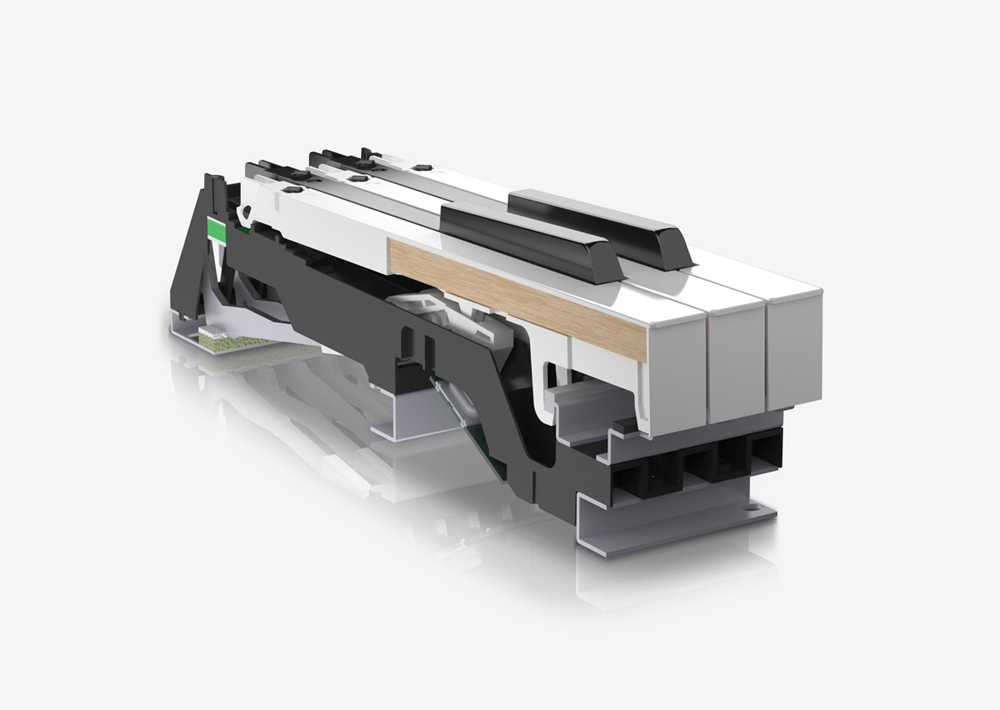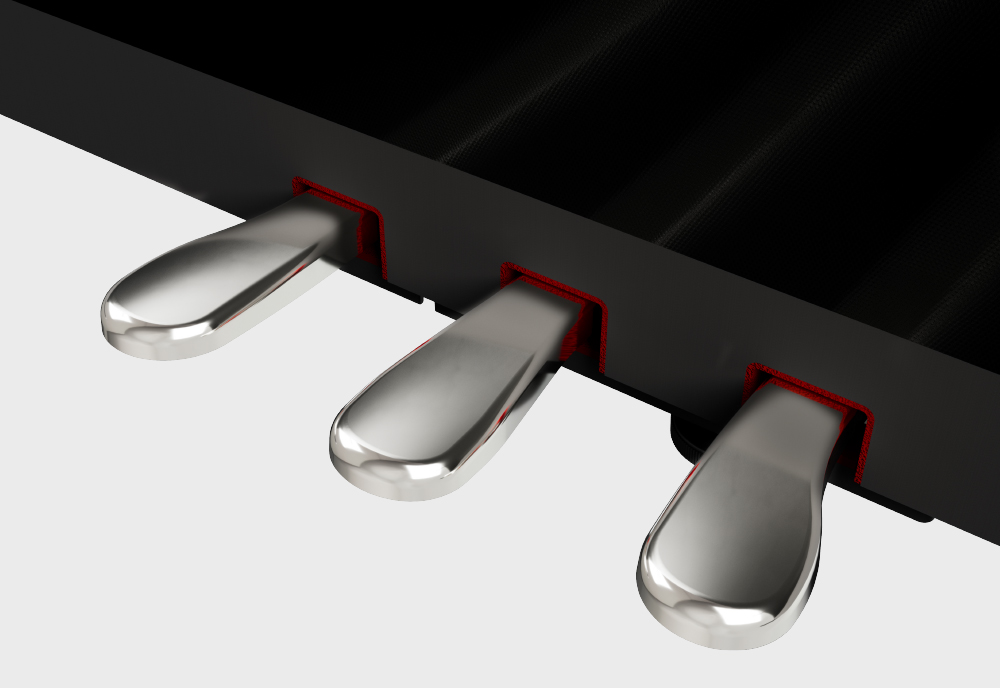From the feel of each key to the intricate number of tones produced, Roland has thought of everything – even when headphones are in use. John Evans looks at the new LX series
Just as art is always evolving, so Roland is constantly developing and refining the art of the digital piano, today represented by its latest models – the GP series of grand pianos and LX series of upright instruments. The story of these remarkable pianos goes back to the V-Piano of 2009, a genuinely ground-breaking instrument that redefined the digital piano. Where other digital instruments use sound samples – essentially multiple recordings of single notes played on an acoustic piano – the V-Piano used physical modelling, an infinitely more versatile and responsive solution with far fewer compromises and which produces not only a more accurate and natural sound at a far wider range of dynamic levels but also a smoother transition between them.
Of course, the V-Piano didn’t just magically appear. The instrument had taken years to develop, in part because the millions of calculations its ‘sound engine’ required to produce the quality demanded by pianists in turn required huge computing power, a task that for many years had been beyond the capability of contemporary microprocessors. However, in 2009 Roland at last considered them to be the equal of its new instrument and so the V-Piano was launched to huge acclaim.
‘Every component, every action and every note is precisely drawn – mathematically’ – Geoff Noronha
The V-Piano’s sound modelling technologies then evolved over the ensuing years, spawning further breakthroughs including SuperNATURAL and, latterly, Pure Acoustic Modelling Technology. ‘Starting with the V-Piano, our focus has always been on using modelling to make the most beautiful and natural piano sound we can,’ says Geoff Noronha, Global Strategic Product Marketing Manager at Roland. ‘Every component, every action and every note is precisely drawn – mathematically. That might sound unnatural but with each step in the development of our instruments, their sound has become more natural, with fewer and fewer compromises in quality throughout the dynamic range.’

The latest step in Roland’s journey is represented by Piano Reality sound technology, the concept at the heart of new GP and LX-series grand and upright pianos. In essence, this approach has the twin aims of boosting definition and dynamic expression, aims that it accomplishes in four ways: improved sound modelling that achieves more complex tonal expression, higher definition sensor detection, a more authentic feeling through the pedals and more natural sound projection.
Pianissimo, forte and everywhere in-between
In fact, Piano Reality sound technology was first seen in the GP series of grand pianos launched in 2023: GP-3 Micro Grand, GP-6 Mini Grand and GP-9 and flagship GP-9M Grand Pianos (pictured below). The news for 2024 is its introduction in the LX series of upright pianos: LX-5, LX-6 and LX-9 but then it’s typical of Roland to find ways of making its high-end technologies available to more pianists.

Beginning with improving tonal expression, thanks to Roland’s new Piano Reality sound engine the new pianos possess rich and complex tones characterised by, for example, a tone that is soft and mellow at pianissimo levels but which becomes more intense towards fortissimo. This mirrors the behaviour of an acoustic piano where the faster the hammer hits the string, the more compressed its head felt becomes and the more strident the resulting tone. Even overtones are modelled to be enriched and sustained in response to the strength of the key touch. ‘The new instruments have a larger palette of tone with more light and shade,’ says Noronha. ‘It’s the ability to refine sound in this way that distinguishes modelling from sampling.’
Having modelled the sound at all levels and intensities, Roland’s next step was to enhance the sense of reality for the pianist hearing the instrument with and without headphones. On other digital pianos this is done using reverb, a solution intended to convey a sense of space. However, in their pursuit of a more natural sound, Roland’s engineers instead modelled how sound behaves in locations ranging from dry practice rooms to concert halls. Surface materials and room proportions all play a part in altering the sound and Piano Reality Ambience achieves this.
The quality of a pianist’s interaction with their piano, by way of the keys, is crucial. In GP and LX-series pianos, Dynamic Sensor Acceleration enhances this experience through a faster-acting and more sensitive key mechanism than ever before. Integrated with the key mechanism, the new sensors give multiple benefits: faster response times from key press to sound, greater sensitivity to the lightest touch and improved performance during high-speed trills when accurately judging key acceleration speed is vital.
All the way down to the feet

The pedals on GP and LX-series pianos have also received attention. On an acoustic piano, when the damper or sustain pedal is depressed, the dampers can be heard leaving the strings, allowing them to vibrate. The dampers can also be heard when the pedal is released and they return to the strings to quell the vibration. The noise is not intrusive and with delicate pedalling cannot be heard at all but it is present all the same. As Noronha explains, Roland’s new Damper Modelling technology conveys this same effect as the pedal is depressed and released, thereby enhancing the sense of realism for the pianist. ‘Damper modelling has enabled us to introduce mechanical noise directly related to the pedal pressure applied – none when the pedal is applied delicately but increasingly so when it is applied with progressively greater force. It might sound strange but in aspiring to make as natural a piano as possible using modelling, it’s important that we make one that also communicates the natural and perhaps unintended sounds of a piano, since in imperfection lies authenticity.’
Finally, Roland has engineered a sound projection system capable of faithfully conveying the sonic benefits of its new Piano Reality sound technology. Where traditional digital pianos that rely on sound samples use conventional tweeters and mid and low-range speaker units, GP and LX-series pianos use a combination of spatial, nearfield and cabinet speakers, plus, new for LX-9, centre-nearfield speakers, the aim being to give a greater sense of the piano’s ‘living’ presence. To achieve this effect, the system not only projects the primary sound of the instrument but also the secondary sounds generated by it including string and soundboard resonance and even the vibrations in the frame and body. ‘Rather than being relegated to treble, mid and bass roles, the speakers in GP and LX-series pianos combine roles to produce the most natural sound possible,’ says Noronha. ‘In this they are supported by a new audio circuit design and an increased power supply capacity that enables a richer and fuller piano sound.’
So welcome to the new Roland GP and LX-series digital pianos featuring Piano Reality sound technology in a choice of contemporary cabinet styles that bring a fresh, new look to traditional piano design. For a natural sound and playing experience on a digital piano, look no further.
Visualise Roland Models in your living room click here


Want to discover more? Purchase The Definitive Guide to Buying the Ideal Piano & Accessories 2025 – your complete guide to the world of buying pianos!







